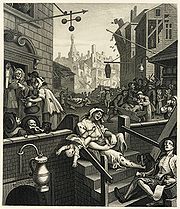
Alcohol tolerance
Encyclopedia

Ethanol
Ethanol, also called ethyl alcohol, pure alcohol, grain alcohol, or drinking alcohol, is a volatile, flammable, colorless liquid. It is a psychoactive drug and one of the oldest recreational drugs. Best known as the type of alcohol found in alcoholic beverages, it is also used in thermometers, as a...
in alcoholic beverages. This includes direct tolerance, speed of recovery from insobriety and resistance to the development of alcoholism
Alcoholism
Alcoholism is a broad term for problems with alcohol, and is generally used to mean compulsive and uncontrolled consumption of alcoholic beverages, usually to the detriment of the drinker's health, personal relationships, and social standing...
.
Consumption-induced tolerance
Alcohol tolerance is increased by regular drinking. This reduced sensitivity requires that higher quantities of alcohol be consumed in order to achieve the same effectsDrunkenness
Alcohol intoxication is a physiological state that occurs when a person has a high level of ethanol in his or her blood....
as before tolerance was established. Alcohol tolerance may lead to (or be a sign of) alcohol dependency.
Heavy alcohol consumption over a period of years can lead to "reverse tolerance". A liver can be damaged by chronic alcohol use, leading to a buildup of fat and scar tissue. The reduced ability of such a liver to metabolize or break down alcohol means that small amounts can lead to a high blood alcohol concentration (BAC) and more rapid intoxication.
Physiology of alcohol tolerance
Direct alcohol tolerance is largely dependent on body size. Large-bodied people will require more alcohol to reach insobriety than lightly built people. Thus, men, being larger than women on average, will have a higher alcohol tolerance. The alcohol tolerance is also connected with activity of alcohol dehydrogenaseAlcohol dehydrogenase
Alcohol dehydrogenases are a group of dehydrogenase enzymes that occur in many organisms and facilitate the interconversion between alcohols and aldehydes or ketones with the reduction of nicotinamide adenine dinucleotide...
s (a group of enzyme
Enzyme
Enzymes are proteins that catalyze chemical reactions. In enzymatic reactions, the molecules at the beginning of the process, called substrates, are converted into different molecules, called products. Almost all chemical reactions in a biological cell need enzymes in order to occur at rates...
s responsible for the breakdown of alcohol) in the liver
Liver
The liver is a vital organ present in vertebrates and some other animals. It has a wide range of functions, including detoxification, protein synthesis, and production of biochemicals necessary for digestion...
, and in the bloodstream. High level of alcohol dehydrogenase activity results in fast transformation of ethanol to more toxic acetaldehyde
Acetaldehyde
Acetaldehyde is an organic chemical compound with the formula CH3CHO or MeCHO. It is one of the most important aldehydes, occurring widely in nature and being produced on a large scale industrially. Acetaldehyde occurs naturally in coffee, bread, and ripe fruit, and is produced by plants as part...
. Such atypical alcohol dehydrogenase is less frequent in alcoholics than in nonalcoholics. Furthermore, among alcoholics, the carriers of this atypical enzyme consume lower ethanol doses, compared to the individuals without the allele.
Alcohol tolerance in different ethnic groups
The tolerance to alcohol is not equally distributed throughout the world's population, and genetics of alcohol dehydrogenase indicate resistance has arisen independently in different ethnic groups. People of European descent on average have a high alcohol tolerance and are less likely to develop alcoholismAlcoholism
Alcoholism is a broad term for problems with alcohol, and is generally used to mean compulsive and uncontrolled consumption of alcoholic beverages, usually to the detriment of the drinker's health, personal relationships, and social standing...
compared to Aboriginal Australians, Native Americans and some East Asian groups. This is related to an average higher body mass, but also to the prevalence of high levels of alcohol dehydrogenase in the population. The high alcohol tolerance in Europeans and some other ethnic groups has probably evolved
Evolution
Evolution is any change across successive generations in the heritable characteristics of biological populations. Evolutionary processes give rise to diversity at every level of biological organisation, including species, individual organisms and molecules such as DNA and proteins.Life on Earth...
as a consequence of centuries of exposure to alcohol in established agricultural societies.
Not all differences in tolerance can be traced to biochemistry. Differences in tolerance levels are also influenced by socio-economic and cultural difference including diet, average body weight and patterns of consumption.
An estimated one out of three people in East Asian countries have an alcohol flush reaction
Alcohol flush reaction
Alcohol flush reaction or Oriental Flushing Syndrome is a condition in which the face and/or body experiences flushes or blotches, due to an accumulation of acetaldehyde...
, colloquially known as "Asian Glow", a condition where the body cannot break down ingested alcohol completely because it lacks the genetically coded enzyme that performs this function in the bodies of drinkers with "European" tolerance levels. Flushing, or blushing, is associated with the erythema
Erythema
Erythema is redness of the skin, caused by hyperemia of the capillaries in the lower layers of the skin. It occurs with any skin injury, infection, or inflammation...
(reddening caused by dilation of capillaries) of the face, neck, and shoulder, after consumption of alcohol.

